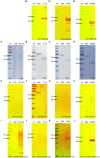Identification of novel biomarkers for anti- Toxoplasma gondii IgM detection and the potential application in rapid diagnostic fluorescent tests
- PMID: 38894968
- PMCID: PMC11184589
- DOI: 10.3389/fmicb.2024.1385582
Identification of novel biomarkers for anti- Toxoplasma gondii IgM detection and the potential application in rapid diagnostic fluorescent tests
Abstract
Toxoplasmosis, while often asymptomatic and prevalent as a foodborne disease, poses a considerable mortality risk for immunocompromised individuals during pregnancy. Point-of-care serological tests that detect specific IgG and IgM in patient sera are critical for disease management under limited resources. Despite many efforts to replace the T. gondii total lysate antigens (TLAs) by recombinant antigens (rAgs) in commercial kits, while IgG detection provides significant specificity and sensitivity, IgM detection remains comparatively low in sensitivity. In this study, we attempted to identify novel antigens targeting IgM in early infection, thereby establishing an IgM on-site detection kit. Using two-dimensional gel electrophoresis (2DE) and mouse serum immunoblotting, three novel antigens, including EF1γ, PGKI, and GAP50, were indicated to target T. gondii IgM. However, rAg EF1γ was undetectable by IgM of mice sera in Western blotting verification experiments, and ELISA coated with PGKI did not eliminate cross-reactivity, in contrast to GAP50. Subsequently, the lateral flow reaction employing a strip coated with 0.3 mg/mL purified rAg GAP50 and exhibited remarkable sensitivity compared with the conventional ELISA based on tachyzoite TLA, which successfully identified IgM in mouse sera infected with tachyzoites, ranging from 103 to 104 at 5 dpi and 104 at 7 dpi, respectively. Furthermore, by using standard T. gondii-infected human sera from WHO, the limit of detection (LOD) for the rapid fluorescence immunochromatographic test (FICT) using GAP50 was observed at 0.65 IU (international unit). These findings underline the particular immunoreactivity of GAP50, suggesting its potential as a specific biomarker for increasing the sensitivity of the FICT in IgM detection.
Keywords: 2DE immunoblotting; IgM detection; Toxoplasma gondii; diagnosis; fluorescence immunochromatographic test; point-of-care test.
Copyright © 2024 Nguyen, Yeo and Park.
Conflict of interest statement
The authors declare that the research was conducted in the absence of any commercial or financial relationships that could be construed as a potential conflict of interest.
Figures








Similar articles
-
[Problems and limitations of conventional and innovative methods for the diagnosis of Toxoplasmosis in humans and animals].Parassitologia. 2004 Jun;46(1-2):177-81. Parassitologia. 2004. PMID: 15305712 Review. Italian.
-
The first study on the usefulness of recombinant tetravalent chimeric proteins containing fragments of SAG2, GRA1, ROP1 and AMA1 antigens in the detection of specific anti-Toxoplasma gondii antibodies in mouse and human sera.PLoS One. 2019 Jun 6;14(6):e0217866. doi: 10.1371/journal.pone.0217866. eCollection 2019. PLoS One. 2019. PMID: 31170254 Free PMC article.
-
Detection of human Toxoplasma-specific immunoglobulins A, M, and G with a recombinant Toxoplasma gondii rop2 protein.Clin Diagn Lab Immunol. 1998 Sep;5(5):627-31. doi: 10.1128/CDLI.5.5.627-631.1998. Clin Diagn Lab Immunol. 1998. PMID: 9729528 Free PMC article.
-
Assessment of an In-House Enzyme-Linked Immunosorbent Assay and IgG Avidity Test Based on SAG1 and GRA7 Proteins for Discriminating between Acute and Chronic Toxoplasmosis in Humans.J Clin Microbiol. 2021 Jul 19;59(8):e0041621. doi: 10.1128/JCM.00416-21. Epub 2021 Jul 19. J Clin Microbiol. 2021. PMID: 34077255 Free PMC article.
-
Preparation of Toxoplasma gondii RH strain antigen, antigen analysis and antigen detection in sera: a review.Southeast Asian J Trop Med Public Health. 2001;32 Suppl 2:195-201. Southeast Asian J Trop Med Public Health. 2001. PMID: 12041589 Review.
Cited by
-
The Development of TIM-Barrel Based Multi-Epitope Protein for Toxoplasma gondii Serological Detection in Cats.Animals (Basel). 2025 Jun 26;15(13):1893. doi: 10.3390/ani15131893. Animals (Basel). 2025. PMID: 40646792 Free PMC article.
-
Exploring glutathione transferase and Cathepsin L-like proteinase for designing of epitopes-based vaccine against Fasciola hepatica by immunoinformatics and biophysics studies.Front Immunol. 2024 Sep 26;15:1478107. doi: 10.3389/fimmu.2024.1478107. eCollection 2024. Front Immunol. 2024. PMID: 39391319 Free PMC article.
References
-
- Alvarado-Esquivel C., Niewiadomski A., Schweickert B., Liesenfeld O. (2011). Antiparasitic treatment suppresses production and avidity of toxoplasma gondii-specific antibodies in a murine model of acute infection*. Eur. J. Microbiol. Immunol. 1, 249–255. doi: 10.1556/EuJMI.1.2011.3.9, PMID: - DOI - PMC - PubMed
-
- Anand N., Lutshumba J., Whitlow M., Abdelaziz M. H., Mani R., Suzuki Y. (2022). Deficiency in indoleamine-2, 3-dioxygenase induces upregulation of guanylate binding protein 1 and inducible nitric oxide synthase expression in the brain during cerebral infection with toxoplasma gondii in genetically resistant BALB/c mice but not in genetically susceptible C57BL/6 mice. Microbes Infect. 24:104908. doi: 10.1016/j.micinf.2021.104908, PMID: - DOI - PMC - PubMed
LinkOut - more resources
Full Text Sources

